How to Improve Organic Click-Through Rates in 2020
If you’ve put any thought or research into the SEO of your business website, you’ve likely encountered the idea of “Organic Click-Through Rate,” or oCTR.
Your business’ click-through rate is often a metric associated with pay-per-click advertising efforts like those available from Google AdWords.
However, organic click-through rates are also a common discussion topic when you’re trying to improve your ranking in organic search results.
If you want to get noticed, you have to improve your organic CTR.
But to do that, you have to first understand what an organic click-through rate is, why it is essential, and what outside factors impact it. Once you know all of that, you can adequately increase your organic CTR and bring your business before the eyes of the masses.
This article will cover it all.
What is an Organic click-through Rate?
A lot of people talk about organic click-through rate, but many don’t truly understand what it is and what it represents.
The organic click-through rate of a website is a ratio that determines the number of users clicking on an organic listing of your business.
Technically, organic click-through rates include any links to your website (social media, directories, etc). For the purposes of this article, though, we’ll be talking about the primary source of organic traffic: your business’ click-through rate from search.
When you appear on a SERP (Search Engine Results Page), your business has received an impression. An impression is counted whether your business’ link is clicked on or not.
So, how many clicks you’ve received divided by the number of impressions you get gives you your organic click-through rate.
Let’s say you run a plumbing website and received 5,000 SERP impressions in a month.
Of those impressions, you’ve gotten 1000 clicks. We divide 1000 by 5,000 to get 0.20. That means this plumber’s organic click-through rate from SERP is 20%.
Organic click-through rates are, ultimately, the reason that investing in SEO is as valuable as it is:
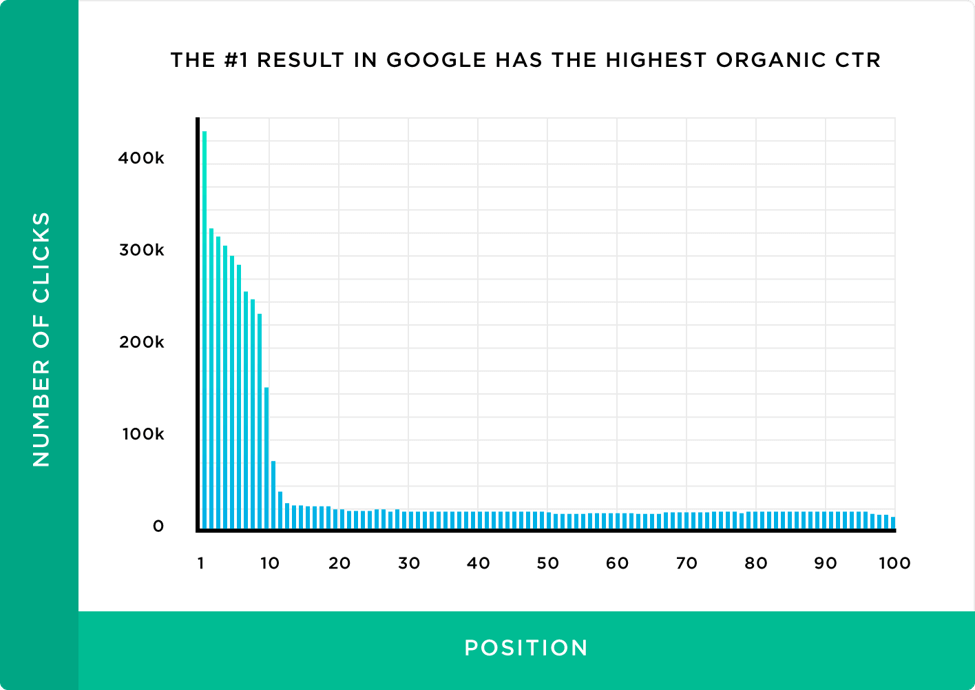
Statistically, the number one result on a SERP has an average organic click-through rate of 31.7%. That number one spot is 10 times more likely to receive a click compared to a link in the number seven spot:
Why is Organic Click-through Rate So Important?
Your organic CTR is one of the most critical metrics for your business’ success. By knowing your organic click-through rate, you’re determining the value of your SERP ranking.
Determining that value helps you figure out a budget for SEO and create a plan with well-defined goals.
It can help you determine an estimate for your organic web traffic as you look into the future. A strong understanding of your organic click-through rate can determine the estimated loss you could see if your site were to drop several spaces in the SERP.
If you’re the number one ranked link for a term, you have an understanding of what your organic click-through rate looks like at that position. As such, you can accurately gauge the loss of traffic you’d see if your rank were to fall, and how much you should invest to keep yourself there.
Setting Your Marketing Budget
Organic CTR allows you to set realistic expectations around your site.
This includes the all-important return on investment, or ROI. If you can set a realistic expectation for conversions based on the organic click-through rate of your SEO goal, you can determine how much profit you’ll be able to bring in once you’ve reached that peak. As such, you’ll be able to estimate your marketing budget accurately.
The goal of any marketing campaign is to bring in more money than you spent on marketing outreach. By having a strong estimate of the profits generated by your goal, you can select a marketing venture that fits within that budget and gives you the most substantial chance for a return.
It should be noted that knowing your organic click-through rate does not give you a quality indicator as to what your traffic will look like as compared to the number of conversions that you see. For that, you’ll have to determine your average conversion rate.
What Is Your Conversion Rate?
Your conversion rate shows how many visitors that came through your site made a purchase or took some form of action.
Google Analytics can be an excellent tool for this. If you know that you have a typical conversion rate of 2.3%, you can accurately predict profitability as your organic click-through rate rises and falls.
Let’s say your website currently ranks at position 6 for a specific term, and you’ve got a 3.4% organic CTR. You’ve determined that taking the top spot will see your organic click-through rate increase by 10 times. That puts you at 34% once you achieve your goal ranking.
If you have 1,000 impressions in a week at position 6, you’re looking at 34 clicks. With a conversion rate of 2.3%, you see barely any conversions.
Now, let’s say you’ve taken the number one spot. With 1,000 impressions, you’re getting 340 clicks with your 34% organic click-through rate. You still have the same conversion rate of 2.3%. However, whereas you once got practically no conversions, you’re now averaging 7.8 conversions per week — just from that one SERP.
Organic Click-Through Rate is More Important Than Ever
As Google’s search engine continues to evolve, the organic click-through rate becomes more important and harder to improve. Fewer organic clicks are coming through Google now because of paid ads run through Google AdWords and advanced SERP features like featured snippets and the local 3-pack.
That’s why it’s important to utilize tools that will grade your website’s organic click-through rate, such as Higher Visibility’s new, Free SEO Click-Through Rate Grader.
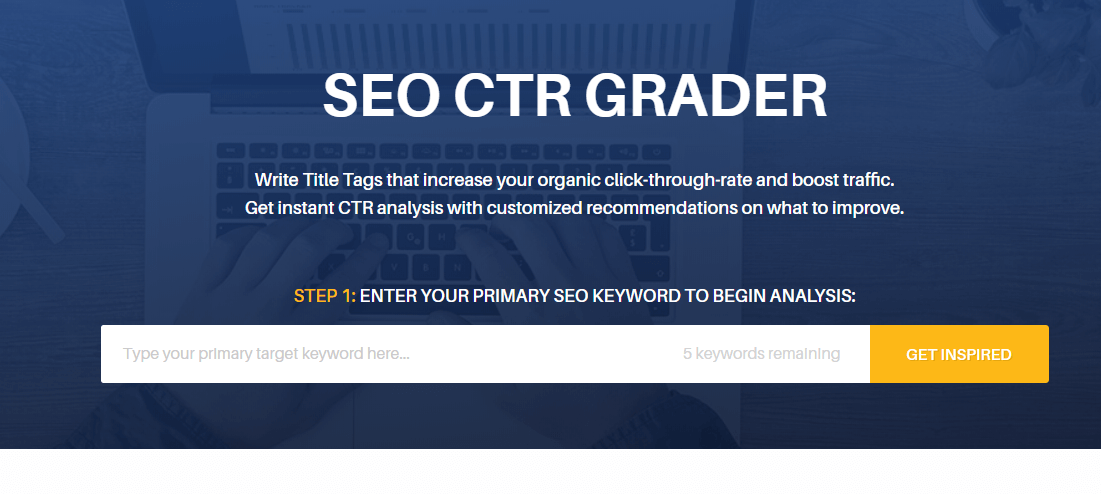
What Factors Impact Your Organic Click-Through Rate?
Now that you understand the organic CTR and its importance, it’s time to discuss the factors that can make it rise or fall. Once you have a mastery of that concept, it will be easier to drive positive movement.
The News Cycle
Our first example is, unfortunately, something that lies outside of your direct control.
The organic click-through rate of your site can be impacted if news articles hinder the search terms you’re trying to rank for.
Let’s say you sell hamburgers, and there’s a huge recall of ground beef. People searching for the generic hamburger search term might find that news articles about the recall are populating the first page over business sites like yours.
While this can be a frustrating setback, it is temporary. Once the news cycle ends, these articles become less relevant and your click-through rate should bounce back once the current event has ended.
Branded Keywords
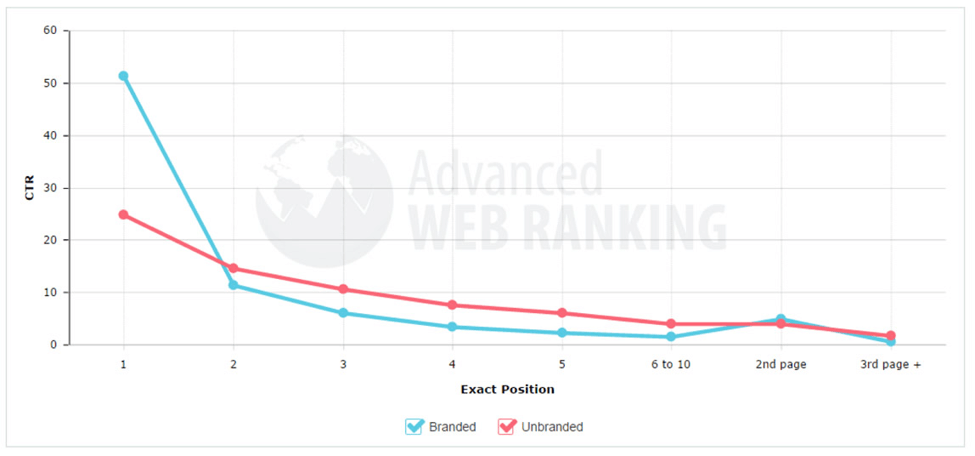
When you’re trying to rank for a keyword, consider something branded over something more generic. A branded keyword will always have a higher click-through rate than a generic term because the user is searching for a particular brand.
In keeping with our earlier example of a hamburger restaurant, the search term hamburger will get fewer clicks than a search term like Big Mac. If you have a burger on your menu that is a great Big Mac alternative, you should be trying to rank for that branded term.
SERP Features
Google has some features that can interfere with your CTR. These features typically pop up before organic search listings and siphon off many clicks.
Featured Snippet
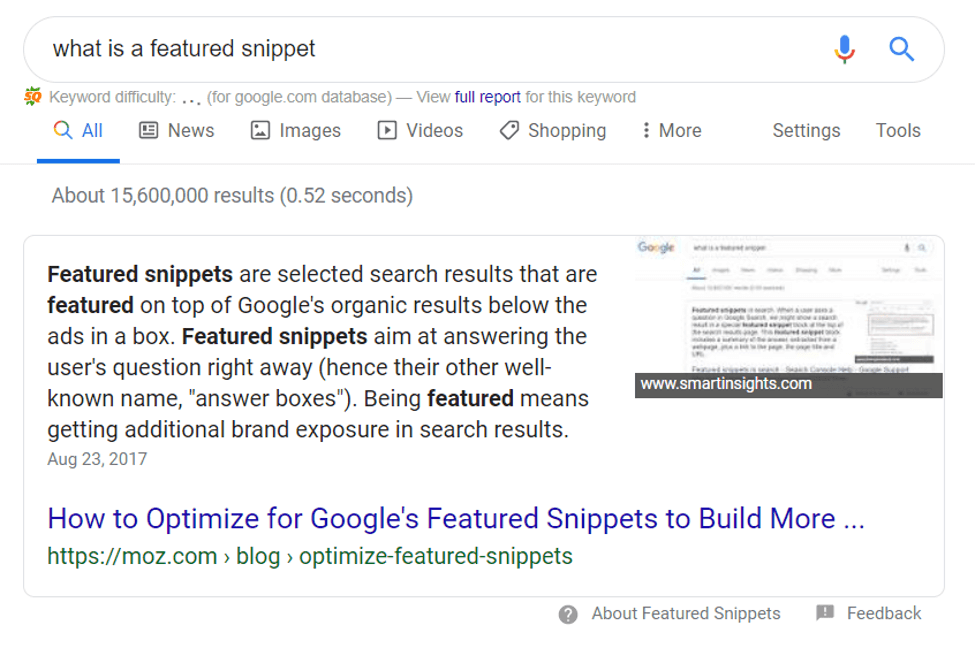
If you’re ranking for a specific question, you might run up against a featured snippet. This is a blurb taken from a high ranking website that seeks to answer the user’s question right on the SERP.
If your site has a blog or seeks to answer specific queries, it’s a good idea to try and rank for a featured snippet.
Local 3-Pack
Local businesses can rank for a local 3-pack, where three businesses are highlighted along with a map before the organic search results.
These specialized results can siphon off clicks from the organic listings, garnering more attention in some cases than even the number one ranked item in the organic results.
Search Intent
Search intent plays a significant role in your placement and, by extension, your CTR.
You should be segmenting your keywords based on user intent. Are people looking for information? Are they looking for specific products? If you understand this, you can better optimize your page and generate more clicks.
Remember, informational searches can generate a featured snippet. Meanwhile, commercial intent keywords typically see a lot of clicks (and local 3-pack listings) as users comparison shop between you and your competitors.
Let’s say you’re an apartment complex looking for new tenants. Commercial intent keywords will benefit you because users looking for an apartment in their area will click around.
User Device
Believe it or not, the device your potential customers use to search on will play a role in determining your click-through rate.
SERPs appear differently on different devices: while mobile searchers are more likely to scroll down the first page, desktop users are more likely to move to a second or third page.
How Do You Increase Your Click-Through Rate?
Understanding the factors that contribute to your CTR can help you increase your ranking and, in turn, your clicks.
Review Current Results
To get where you want to go, you first have to understand where you are. Review your current organic CTR results first to better understand where the shortcomings of your site might be.
You can find your CTR results through the Google Search Console. Just click on Performance and then Search Results Report.
Select the pages you want to get results on and click on total clicks, impressions, and average CTR.
Sorting your results by the number of impressions will show you which pages are your most productive. This is also a great way to identify pages that are not performing well so that you can re-evaluate them.
Research Longtail Keywords
Search phrases with higher word counts are called longtail keywords. They are particularly useful when trying to improve the organic CTR for blog articles.
The inclusion of longtail keywords should be an essential part of any SEO strategy. Integrate longtail keywords to increase the volume of your organic queries and create more opportunities to generate clicks.
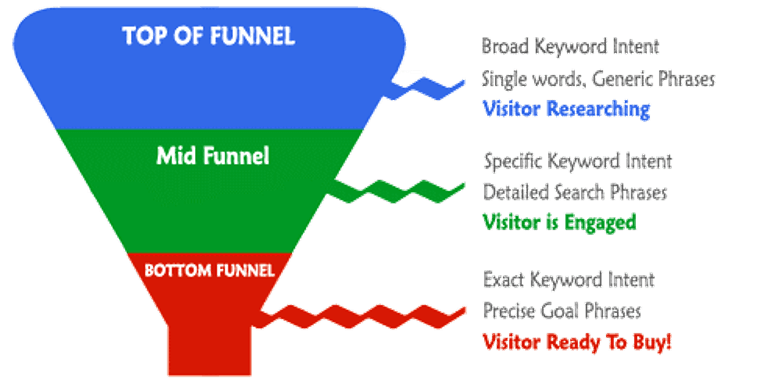
Longtail keywords fall into what’s commonly referred to as the SEO funnel:
Single keywords are useful for the top of the funnel, where generic phrases and broad intent are used by people researching services or products that they’re looking for. Longtail keywords are more useful for the mid-funnel and bottom-funnel when the user is engaged and ready to buy.
Add Impactful Meta Descriptions
The meta description is what shows up in a SERP entry. By creating an engaging, descriptive, and optimized description of your pages, you could tip the click balance in your favor.
Sometimes, a reliable description could garner you clicks over pages that are ranked ahead of you.
Google gives you 160 characters for meta descriptions. Use them all or as close as you can get.
Include Structured Data
Structured data, also known as schema markup, is code that makes it easier for search engines to crawl and display content.

A search engine like Google already knows the “what” of your data. Structured data gives it the “why.” If you have a product listing, Google knows that it’s a product listing. Structured data gives it more specific information on your listing that it can use when determining placement.
Structured data can be used to create rich snippets on the SERP. A rich snippet includes extra information between a URL and a description. This can include images, ratings, and other information that will catch the eye of a searcher.
Add Images
Images not only increase engagement, but they can get your pages listed in image results on Google. That’s a whole other area in which you can rank and generate clicks.
Remember, your images have to be high quality and relevant to the page, or Google won’t bother with them. Images can also show up in rich snippets.
Provide Descriptive URLs and Titles
Your URL and title tag should say something about what your page is about.
This helps you with SEO placement but also informs potential visitors. If they see something familiar or related to their search in your URL or title, they might be more likely to click, even if you’re not the number one ranked item on the SERP.
Final Thoughts
Understanding the importance of your organic CTR and using that information to improve your standing and clicks can help you achieve greatness in the SEO world.
It’s important to understand where you currently are by using an Organic CTR Tool. That’s the surest way to up your clicks and get noticed in the increasingly crowded search engine atmosphere.
